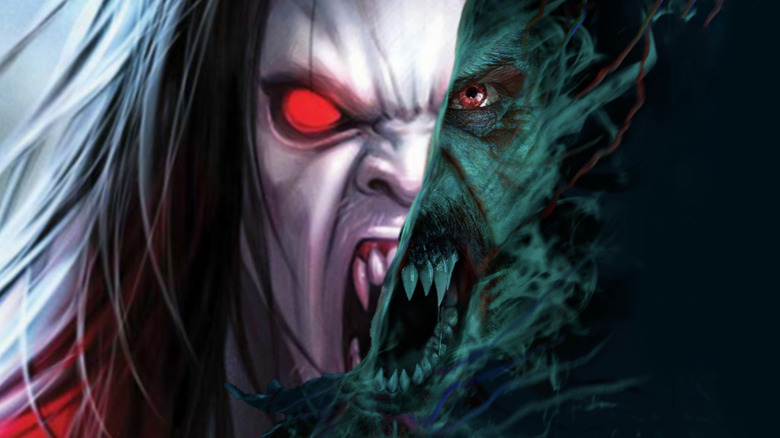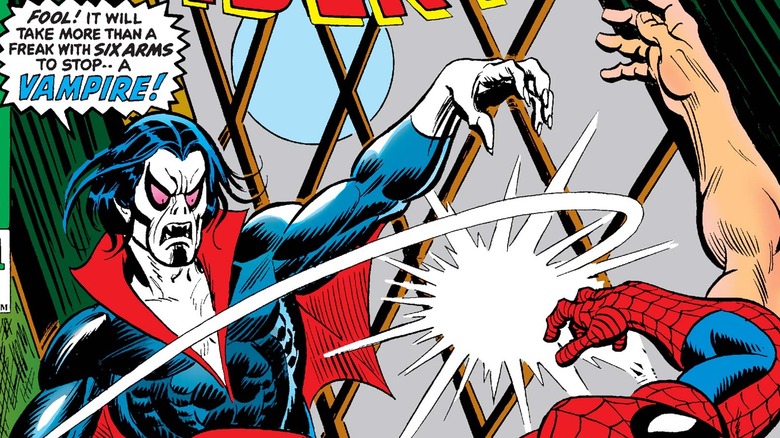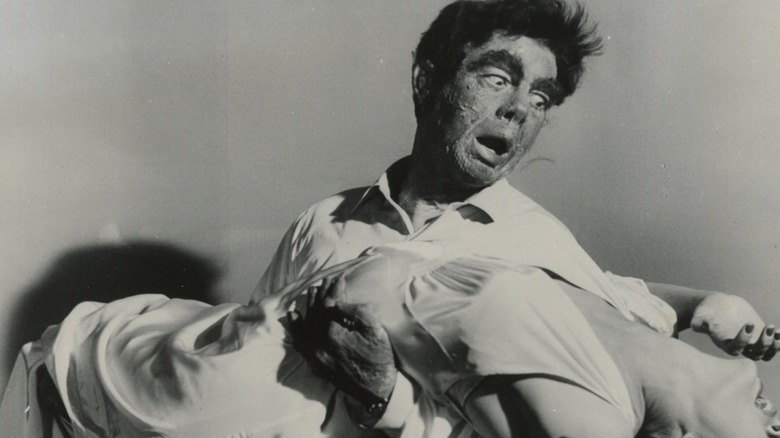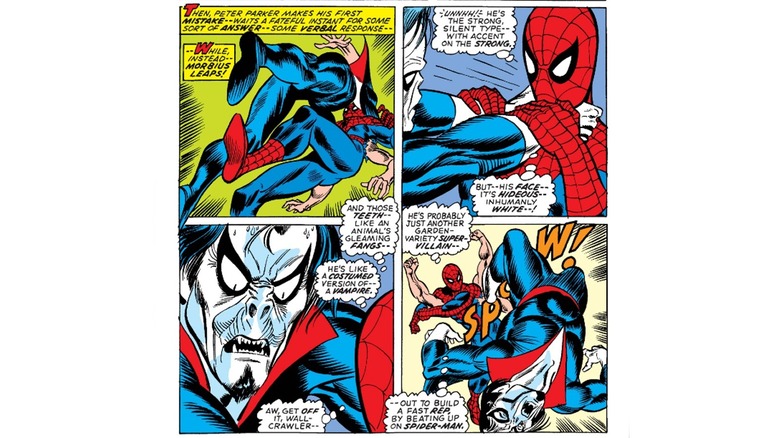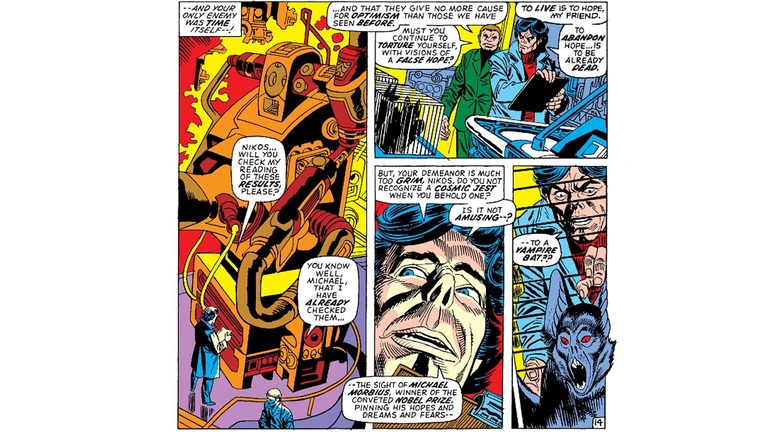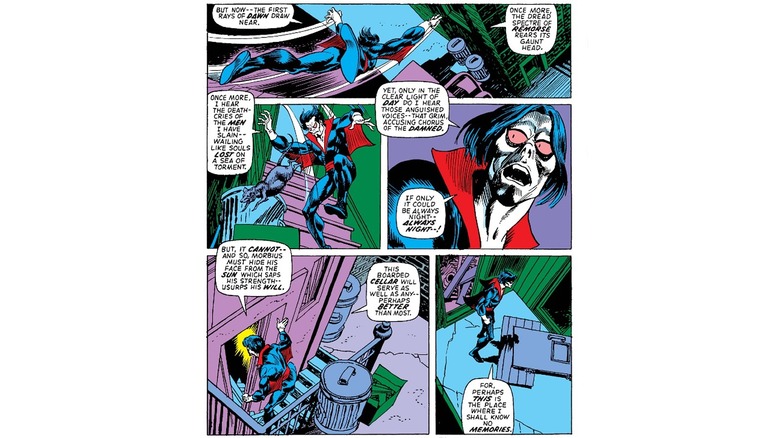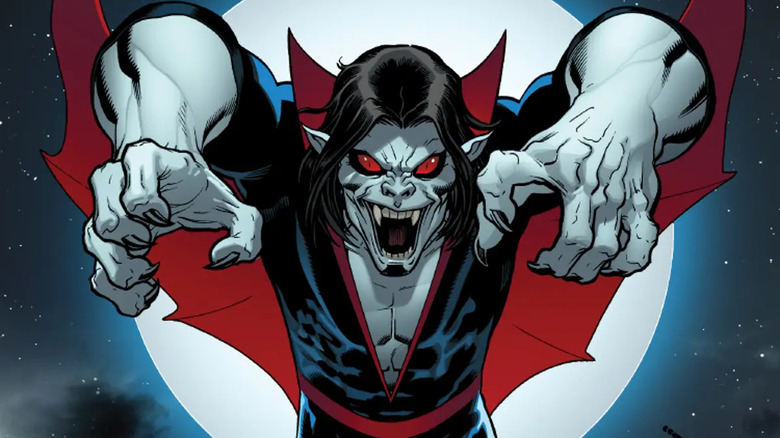How Morbius Compares To His Original Comic Book Appearance
Last week, audiences were introduced to Morbius, the Living Vampire. The occasional Spider-Man antagonist headlined his own film, "Morbius," where he was portrayed by Oscar-winning actor Jared Leto. Despite many harsh reviews and muted audience reception, "Morbius" was the number one film at the box office.
The film is just an adaptation of the Marvel Comics character, however, presenting a version of Dr. Michael Morbius who isn't tied to Spider-Man at all. At the same time, it sands away some of the rough edges around the character and flattens years of storytelling to present a unified vision of Morbius.
Morbius was introduced in "The Amazing Spider-Man" #101, written by Roy Thomas and drawn by Gil Kane. That issue and the following one gave Morbius his origin and threw him into a tussle between a six-armed Spider-Man and the Lizard. While the movie's biggest sin is the complete lack of Morbius' red-and-blue deep-V jumpsuit, it's worth taking a peek at how the good doctor is presented in the film versus his first comic appearance.
There are no monsters here
Before we get to the comic issues at hand, you need to dive into the genesis of Morbius. For nearly two decades prior to the release of "The Amazing Spider-Man" #101, the Comics Code Authority (CCA) prevented the use of supernatural monsters in comics. The Code itself was preemptive self-censorship by the Comics Magazine Association of America (CMAA), which wanted to get ahead of public concerns about violent and gory comics.
Horror and crime comics were big at the time, reflecting the pulp roots of comic books. So the CCA outright banned vampires, werewolves, and zombies; curtailed the portrayals of standard criminals and police officers; and cracked down on any sexual content. That held until the Code was revised for the first time on January 28, 1971, allowing the return of some monsters and even lessening the restrictions on showcasing criminal behavior. The trick was vampires and werewolves could only return if they leaned on classical literary versions.
Into this new gap, horror fan Roy Thomas would throw his spin on the classic vampire.
Dracula by another name
In an interview with Twomorrows, Thomas admitted that his original desire for "Amazing" #101 was to introduce Dracula himself as an antagonist. "Stan said, no he wanted a super-villain vampire, so we made up Morbius, whom we made not a real vampire," said Thomas. Dracula would later join the Marvel Comics universe with "The Tomb of Dracula" #1, published in 1972.
Thomas and Kane would instead create Morbius, who owed his inspiration to the 1957 black-and-white film "The Vampire," according to Thomas in an interview with Universal Monsters Universe. In that film, Dr. Paul Beecher ends up taking pills based on the blood of vampire bats, forcing him to ingest blood to survive. It's a Jekyll-Hyde tale with a vampire twist. Pills laced with vampire bat blood aren't enough in the face of the radiation-heavy origins of characters like Spider-Man and Hulk though. So Thomas lifted the idea and gave it a super-science spin as befits the Marvel Universe.
Doctor Morbius, I presume?
As presented in "Amazing" #102, Dr. Michael Morbius is a Nobel Prize-winning doctor dying of a mysterious blood disease. Searching for a cure, Morbius turns to a combination of vampire bat fluid, radiation, and electricity, only to turn himself into a Living Vampire! The failed experiment takes place on a private yacht, and in his new state, Morbius kills his best friend Nikos and abandons the ship. He ends up on another ship, where he kills the crew and ends up in Southampton, New York. It's here he meets Spider-Man, who is hiding out trying to cure himself of the additional arms he grew after trying to get rid of his Spider-Powers completely. It's a long story and comic book nonsense at its finest.
Most of this origin is present in "Morbius." In fact, it's surprising how close the movie sticks to the comic origin! Once again, Dr. Michael Morbius has a mysterious blood disease that's killing him. He charters a mercenary vessel into international waters to conduct an experimental cure that will splice his genes with that of vampire bats. The cure works, making him super-strong, but also giving him a great hunger for blood. He kills the crew — they're all bad people, don't worry! — and leaps overboard, swimming back to New York.
The big changes here are more to streamline and enhance some dramatic weight. In the comic, upon changing, Morbius kills his best friend Nikos. Overcome with grief, he abandons ship and kills the crew of the ship that finds him. In the film, the crew is part of the ship where the experiment happens and they're all bad guys so that our hero doesn't slaughter a ship full of innocent folks. The film also replaces Nikos — who does eventually become a vampire in the comics after being bitten by Nazi vampire Baron Blood — with the original character of Milo (Matt Smith).
No one nose the truth
In "Morbius," Michael Morbius is infirm due to his disease, but generally hot. After his experiment though, he not only remains Jared Leto, but he gets abs that you could cut granite on. He only reverts to his more animalistic form, with the grey skin and upturned nose, when he has too little or too much blood.
In the comics, Michael Morbius just has a weird upturned nose. This looks to be another reference to "The Vampire," where Dr. Paul Beecher's vampiric form has a similar style of nose, likely due to the heavy makeup. Maybe it's supposed to be a result of his mysterious disease?
Regardless, Morbius knows his face is a bit unfortunate, telling his girlfriend Martine Bancroft, "Is it not enough that fools snicker behind your back, because you love one as hideous as myself?" The major difference when he becomes a faux-vampire is his near-white skin and red eyes. His vampiric countenance is just a slightly-altered version of himself, rather than a marked change like it is in the film.
All of death is a stage
The introductory tale for Morbius in the comic showcases the verbose nature of the character, with the title proudly stating "A Monster Called... Morbius!" The striking thing is that this Michael Morbius talks like a movie vampire, even before he officially becomes one.
Take this wonderful monologue when Morbius finds himself on the shores of Southampton:
"The night! Only then can I bear the thought of — what I am. Daylight saps me of my will — dead men's faces glower at me — Lifeless fingers point —rasping voices say, 'J'accuse!'"
Or Morbius lamenting the murder of his best friend:
"Dead! Because you loved me, Nikos. But — perhaps you are the fortunate one. For, what of me, Nikos. What is this thing that Morbius has become! You know word well, don't you, Nikos? And the word is — VAMPIRE!"
Amazing stuff, fit for the stage.
In the film, Dr. Michael Morbius has no grand pronouncements! Nay, instead he sits silent and stoic, holding back the words and deeds in his mind. Jared Leto, the actor who puts his heart's blood on the floor with every role, instead holds back his fiendish smiles and barbed epithets! To what end did they cast Leto, if not to throw loose the gates of acting and soliloquize stridently, belting every syllable with bravado?
Ahem. Sorry. Yeah, Leto in the film is just a guy. Not even a particularly charismatic one either, as Matt Smith, playing Milo, gets to have the most fun during his villainous turn.
Suit up for the first time
Let's also pour out a goblet of blood for the Morbius' costume from the comics. As I mentioned before, his classic garb is a red-and-blue jumpsuit, sporting a popped collar, deep open V-neck down to his abs, and some sort of attached mantle or cape. He's had mostly the same look in the comics for ages, despite the suit not being tied to his powers. It's just the inner suit from his initial experiment, and Morbius never took it off. Who am I to judge such fashion?
It's a stone-cold unique look though, one that never appears in the film. Instead, Morbius tends to simply wear black in the film. That somewhat makes sense — you need to hide the blood — but I have seen Leto on the red carpet? Surely he wanted something flashier than this. Morbius in the film needed to make a statement and nothing screams louder than a bright red collar and a v-neck.
I wanted "Morbius" to go further and lean wholly into the roots of the comic. Morbius is an absurd character, a fake vampire that fights Spider-Man because he happens to end up in the same building. That should've been reflected in the film, and sadly it was not, potentially to its detriment.
